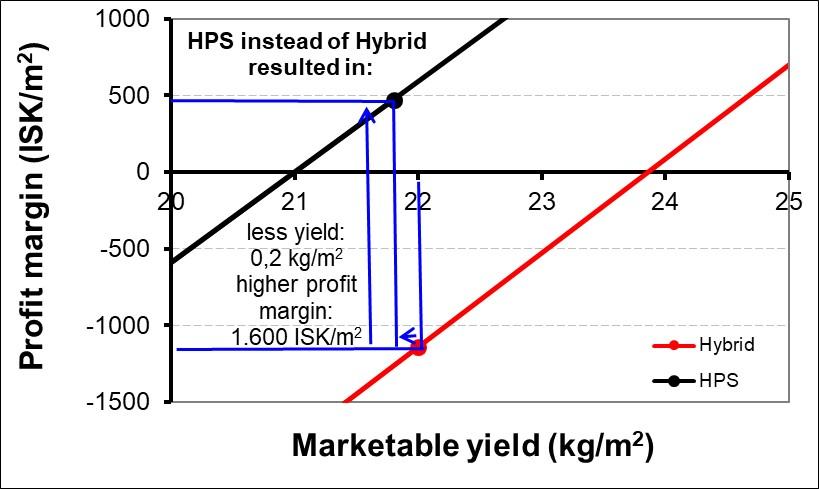
3 minute read
Fig. 39: Profit margin in relation to yield with different light sources in tomato production – calculation scenarios
Hybrid treatment would have been nearly 3 kg/m2 higher, would the profit margin have been comparable to the treatments that received HPS lights. However, the profit margin was negative for the Hybrid treatment. To be able to get a positive profit margin would a yield increase be necessary: Yield must reach nearly 24 kg/m2 .
Fig. 39: Profit margin in relation to yield with different light sources in tomato production – calculation scenarios.
Dueck et al. (2012b) reported that the production under LEDs was lower than under HPS, but LEDs saved 30% of dehumidification and heat energy and 27% of electricity relative to the crop grown with HPS lights. Särkka et al. (2017) mentioned that the electrical use efficiency (kg yield J-1) increased when HPS light was replaced with LEDs in cucumbers. When LED lights and interlights were used the light use efficiency (g fruit FW mol-1 PAR) was highest but resulted in a fewer number of fruits in mid-winter particularly and the lowest yield potential. However, the high capital cost is still an important aspect delaying the LED technology in horticultural lighting. The high investment costs for LEDs are one reason why it is more economic to invest rather in HPS lights with an electronic ballast and 1000 W bulbs instead of 750 W bulbs. Singh et al. (2015) showed that the introduction of LEDs allows, despite of high capital investment, reduction of the production cost of vegetables and
ornamental flowers in the long run (several years), due to the LEDs’ high energy efficiency, low maintenance cost and longevity.
So far, limited information is available comparing HPS supplemental lighting with LED supplemental lighting in terms of plant growth and development (Hernández & Kubota, 2015). Reported results are controversial, first because of different plant species and cultivars are used and second due to various experimental conditions (Appolloni et al., 2021). Therefore, it is concluded by different authors (Bantis et al., 2018; Gómez et al., 2013; Hernández & Kubota, 2015; Singh et al., 2015), that more detailed scientific studies are necessary to understand the effect of different spectra using LEDs on plant physiology and to investigate the responses to supplemental light quality of economically important greenhouse crops and validate the appropriate and ideal wavelength combinations for important plant species. Despite of the fact that in a Hybrid system the effect of LEDs is less pronounced compared to the only use of LEDs, even less information is available regarding the effect of a mixed HPS + LED top lighting system (Rakutko et al., 2020). Therefore, the above stated conclusion is also valid for Hybrid lighting.
Särkka et al. (2017) concluded that at the current stage of LED technology, the best lighting solution for high latitude winter growing appears to be HPS top lights combined with LED interlights. However, a solution for the near future could be a combination of LED and HPS as top lights, to be able to maintain a suitable temperature, but reduce energy use. This is in accordance with Dueck et al. (2012a) who suggested that a combination of HPS and LEDs as top lighting is the most promising alternative for greenhouse grown tomatoes in the Netherlands when taking into consideration different production parameters and costs for lighting and heating. Rakutko et al. (2020) stated that the use of a Hybrid lighting system is the best available technique as it significantly increased the efficiency of light energy use by cultivated plants leading to shorter pre-fruiting period, higher plant productivity, improved commercial quality of fruits and higher sugar and vitamin content in them. Verheul et al. (2022) concluded that artificial HPS top lighting is more efficient for tomato production than LED interlighting. This was in accordance with recent experiments (Stadler, 2021b) as well as to the present experiment, where it is recommended to use rather LED lights as top lightings and no LED interlights. However, taking the investment costs into account, HPS top lights (1000 W) are







